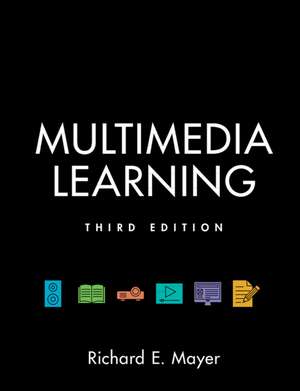Multimedia Learning
Autor Richard E. Mayeren Limba Engleză Paperback – 8 iul 2020
| Toate formatele și edițiile | Preț | Express |
|---|---|---|
| Paperback (1) | 263.94 lei 3-5 săpt. | +41.87 lei 7-13 zile |
| Cambridge University Press – 8 iul 2020 | 263.94 lei 3-5 săpt. | +41.87 lei 7-13 zile |
| Hardback (1) | 795.64 lei 6-8 săpt. | |
| Cambridge University Press – 8 iul 2020 | 795.64 lei 6-8 săpt. |
Preț: 263.94 lei
Nou
Puncte Express: 396
Preț estimativ în valută:
50.50€ • 52.87$ • 41.79£
50.50€ • 52.87$ • 41.79£
Carte disponibilă
Livrare economică 15-29 martie
Livrare express 01-07 martie pentru 51.86 lei
Preluare comenzi: 021 569.72.76
Specificații
ISBN-13: 9781316638088
ISBN-10: 1316638081
Pagini: 450
Dimensiuni: 189 x 245 x 22 mm
Greutate: 0.95 kg
Ediția:3Revizuită
Editura: Cambridge University Press
Colecția Cambridge University Press
Locul publicării:Cambridge, United Kingdom
ISBN-10: 1316638081
Pagini: 450
Dimensiuni: 189 x 245 x 22 mm
Greutate: 0.95 kg
Ediția:3Revizuită
Editura: Cambridge University Press
Colecția Cambridge University Press
Locul publicării:Cambridge, United Kingdom
Cuprins
Part I. Introduction to Multimedia Learning: 1. The promise of multimedia learning; 2. The science of learning: determining how multimedia works; 3. The science of instruction: determining what works in multimedia learning; 4. The science assessment: determining what is learned; 5. Multimedia principle; Part II. Principles for Reducing Extraneous Processing in Multimedia Learning: 6. Coherence principle; 7. Signaling principle; 8. Redundancy principle; 9. Spatial contiguity principle; 10. Temporal contiguity principle; Part III. Principles for Managing Essential Processing in Multimedia Learning: 11. Segmenting principle; 12. Pre-training principle; 13. Modality principle; Part IV. Principles for Fostering Generative Processing in Multimedia Learning: 14. Personalization principle; 15. Voice principle; 16. Image principle; 17. Embodiment principle; 18. Immersion principle; 19. Generative activity principle; Part V. Conclusion: 20. Principles of multimedia design.
Recenzii
'Richard E. Mayer's Multimedia Learning has influenced generations of students worldwide. Written in his signature accessible style, this updated third edition provides a state-of-the-art overview on current knowledge of how (not) to design multimedia learning materials. It will be an invaluable resource for students, educators, and researchers alike.' Tamara van Gog, Professor of Educational Sciences, Utrecht University, The Netherlands
'This book offers a key contribution to the growing area of multimedia instruction for promoting human learning. It expertly integrates theoretical and practical considerations for research on multimedia learning. The third edition is a valuable resource for those planning to optimise multimedia resources for educational advancement.' Olusola Adesope, Boeing Distinguished Professor of STEM Education, Washington State University, USA
'Richard E. Mayer is the father of research into multimedia learning. The scope, details and direction of the field have been largely determined by his work. The previous editions of Multimedia Learning provided the best summary of the field. The consequent high expectations of the third edition are fully met.' John Sweller, Emeritus Professor of Educational Psychology, University of New South Wales, Australia
'This textbook is a labor of love covering three decades of research on how to combine words and pictures in educational technologies. This updated edition reviews evidence on when principles should be implemented, boundary conditions, and avenues for future research. It is a must read for students, practioners, and scientists who design multimedia for learning!' Danielle McNamara, Director of the Science of Learning and Educational Technology (SoLET) Laboratory, Arizona State University
'This book offers a key contribution to the growing area of multimedia instruction for promoting human learning. It expertly integrates theoretical and practical considerations for research on multimedia learning. The third edition is a valuable resource for those planning to optimise multimedia resources for educational advancement.' Olusola Adesope, Boeing Distinguished Professor of STEM Education, Washington State University, USA
'Richard E. Mayer is the father of research into multimedia learning. The scope, details and direction of the field have been largely determined by his work. The previous editions of Multimedia Learning provided the best summary of the field. The consequent high expectations of the third edition are fully met.' John Sweller, Emeritus Professor of Educational Psychology, University of New South Wales, Australia
'This textbook is a labor of love covering three decades of research on how to combine words and pictures in educational technologies. This updated edition reviews evidence on when principles should be implemented, boundary conditions, and avenues for future research. It is a must read for students, practioners, and scientists who design multimedia for learning!' Danielle McNamara, Director of the Science of Learning and Educational Technology (SoLET) Laboratory, Arizona State University
Notă biografică
Descriere
This book examines how people learn from words and graphics and provides 15 evidence-based principles for designing multimedia instruction.
